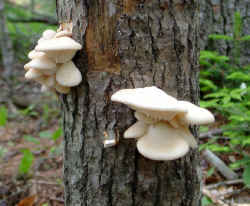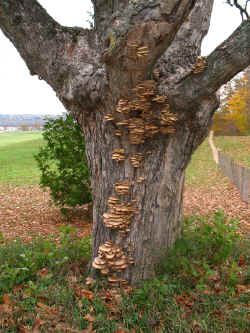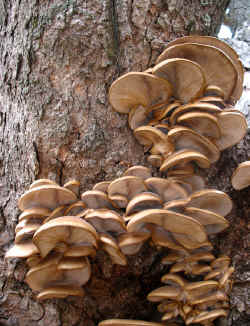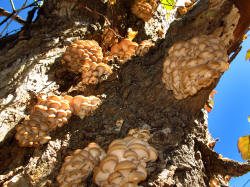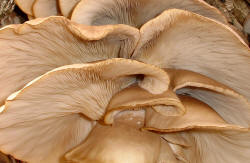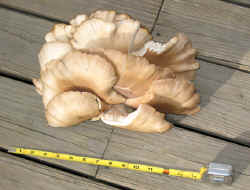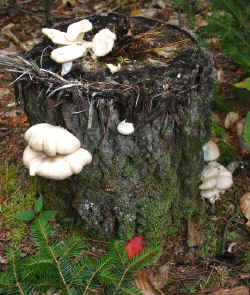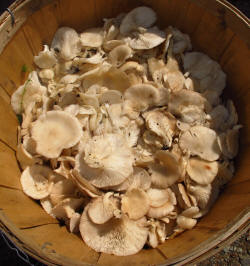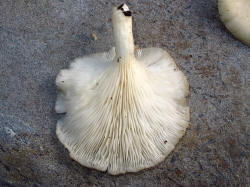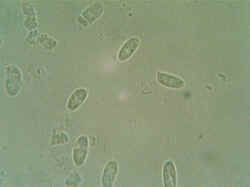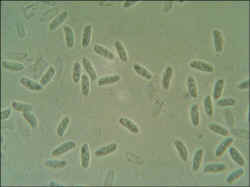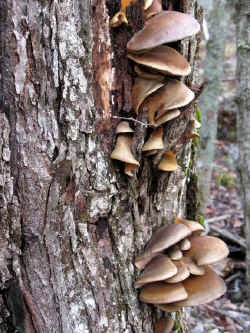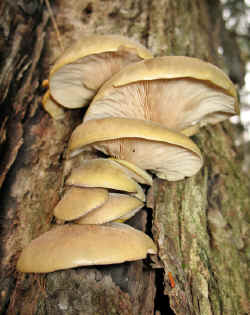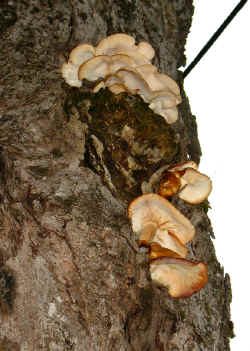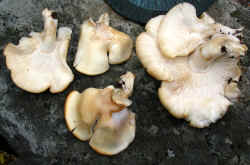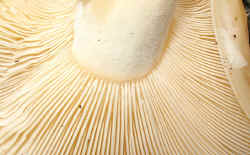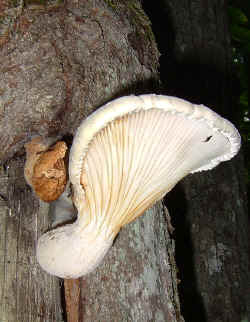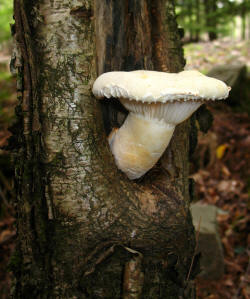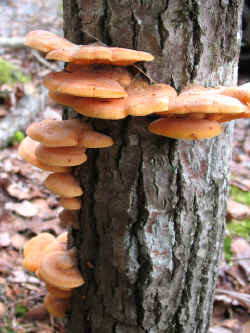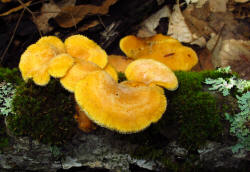|
|
A New England and Eastern Canada Edible and Medicinal Mushroom Resource |
||
|
Oyster Mushroom We have two species of "true" oyster mushrooms that predominate in central Maine. Up until recently I thought there was only one since prevailing wisdom said Pleurotus ostreatus could have a white or lilac/lavender spore print. A few years back we used to call the lavender spored variety Pleurotus sapidus but no more. That epithet has apparently been "deprecated". The taxonomy of these is still in flux. These are more of a complex. Pleurotus ostreatus grows in the fall to early winter. The almost identical Pleurotus populinus, a recently described species, grows in late spring and occasionally throughout the season on poplar/aspen. Before Pleurotus populinus was defined as a distinct species, it was considered a spring P. ostreatus with a white spore print. Now the fall oyster previously known as Pleurotus sapidus is known as the "true" P. ostreatus. It generally has a lavender/lilac spore print if allowed to develop any thickness. These species are good edibles with medicinal properties. There are several other species of oysters that may appear sporadically. Pleurotus pulmonarius is usually found in summer especially on beech and sometimes other hardwoods. It is somewhat uncommon. It has thinner flesh and a stem often close to the center. Cap (pileus) 1 - 12 inches wide, 1/2 to 1 1/2 inches thick. Convex and semicircular to fan shaped, overlapping in large bunches. Either species usually has a strong anise-like aroma. Older fruit bodies may develop some off aromas. Pleurotus ostreatus cap color is likely to be tan to brown but can be whitish, grayish or even gray-blue. The gray-blue color is more likely to be seen in cultivated P. ostreatus of European origin. Pleurotus populinus has a whitish ivory cap. Gills (lamellae) Fairly close together running down the stem and white, light gray or tannish. Pleurotus populinus is likely to be whitish ivory. P. ostreatus will have more variation in color being usually tan to brown. Stem (stipe) Usually nonexistent to stubby unless growing on top of a log and bunched together (cespitose). Flesh Thick, white and non bruising. Spores P. ostreatus makes a whitish gray or lavender/lilac spore print. The thicker the spore print is, the more likely some color will show. P. populinus makes a white to very slightly grayish spore print. When and where to find them (ecology) Pleurotus populinus is mostly found in late May and early June growing on dead poplar (aspen) exclusively. I find them on both quaking aspen and eastern cottonwood. They may appear sporadically throughout the summer especially after a heavy rain. I have not found them on a living tree but it is probably possible. They have a strongly anise/almond aroma. Pleurotus ostreatus is found from mid Fall to mid December and seems to prefer sugar maple and occasionally beech, or other hardwoods. These are likely to be on living mature trees with obvious signs they are on the way out or occasionally on dead wood. They can be very high in the tree and grow in enormous numbers. They can be harvested year round in the produce section of most supermarkets. Preparation (Pleurotus ostreatus or P. populinus) is a fairly good mushroom when sautéed, though it's flavor is a bit understated and the texture can be a bit chewy. When cooked with tempura batter it's goodness really comes out. Oysters have a beautiful anise/almond aroma when first picked. This aroma is ephemeral often dissipating within a few hours. If you can pick and cook them within a short time, the tempura will retain some of that anise/almond character. Very nice. They are not very successful as a dried product. The texture is leathery when reconstituted and as powder the flavor is far less exciting than many other mushroom powders. I consider them to be a bit over rated as an edible. They can easily become chewy by a number of techniques. I have found that they make a satisfactory duxelles. Duxelles is a paste used to flavor soups, as a base for sauces, as a garnish, or stuffing. Escoffier's recipe for duxelles is made by finely chopping mushrooms or leftover stems and peelings and sautéing them in butter with onions, adding nutmeg and parsley or other spices. Julia Child's recipe leaves out the onions. You might also consider using shallots, garlic, wine, or other spices. Duxelles can then be frozen. See Evaluating Flavor using basic cooking processes for more information. Since oysters are easy to grow, possess medicinal properties, and are quite common they should continue to be popular. Comments Pleurotus ostreatus or P. populinus look exactly alike except for slight color differences. Either one left sitting on a table will eventually drop an enormous amount of spores in a wide circle. Mycelium of these species grown in the same petri dish do not get along with each other indicating that they are separate species. Pleurotus ostreatus is quite easy to cultivate growing on a wide variety of substrates. Pleurotus populinus appears to only like poplar/aspen species. I could not get vigorous mycelium to grow on potato agar. I can get P. ostreatus to grow on practically anything. Cutting off the stems and bark and placing them in wet sawdust or soaked dowels plugs will often result in aggressive growth creating spawn you can use for stump, log, or other inoculation purposes. I have a large number of P.populinus logs in my yard I have brought from the woods. I cut them into 3 foot bolts with my chainsaw. This may be a strategy you can try. When found in the woods, after a heavy fruiting, the wood gets much softer and insects move in. This attracts the hairy and pileated woodpeckers that often dismantle the tree leaving just a pile of chips on the ground. The woodpeckers don't bother the logs I have laid out in my yard too much. Pleurotus species have some medicinal value and probably should remain on your menu for that reason. There have been some studies done indicating that polysaccharides in Pleurotus ostreatus may be used in treatment of prostate cancer and other cancers. Paul Stamets has demonstrated that strains of oyster mushrooms he has developed can break down the structure of hydrocarbon molecules effectively cleaning up pollution such as diesel fuel, oil, gasoline, PCBs, and similar pollutants. I may try it with my strain this winter. There are a number of bioremediation strategies possible using Pleurotus species. I have experimented with growing oyster mycelium on a number of unusual substances. I am hoping to get a few mushrooms from that old cotton LL Bean shirt I was going to throw away. It has pinheads on it now. I have mycelium growing on dryer lint and coffee grounds. Oysters can be used for dyeing wool, some fabrics, or paper and will yield a gray-green color with wool when using and iron pot and ammonia as modifiers. Pleurotus pulmonarius grows in summer and is somewhat uncommon in Maine. It usually has a stem and often will be found on conifers or oak. It is edible and good. Pleurotus dryinus (edible) also occasionally found in summer has a felt-like stem that tends to join off center under the cap and grows singly or in smaller numbers on hardwoods such as maple. Hypsizygus tessulatus, known as an "elm oyster" (edible) may be found on various hardwoods in fall. It has a prominent stem and gills that do not run down the stem. The similar and true "elm oyster" Hypsizygus ulmarius, (edible) looks quite similar. Hypsizygus sp. are a huge taxonomic problem at this point with a lot of conflicting information in both field guides and on websites. Late fall oyster (Panellis serotinus) is brownish with green and yellow tones and slightly different gills that have a sharp ending at the stem. They are a culinary disappointment being quite chewy and often slightly bitter. Angel wings (Pleurocybella porrigens) are thin and white growing on conifers. There have been some reports of poisoning recently although most field guides list them as edible. Angel wings should be avoided. Crepidotus species are very small and have a brown spore print. They should not be eaten. Lentinus/Lentinellus are tough and have hairy brown caps, an off smell and a bad taste. Remember, young, fresh oysters have a lovely aroma! Find more information here: Pleurotus populinus
at MushroomExpert.com Use of this site will constitute your acceptance of the disclaimer. Copyright 2013 Mushroom-Collecting.com. All rights reserved |


